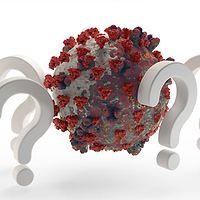As food manufacturers, when we hear the word "niche" we usually think of an environment that can harbor and sustain the growth of spoilage or pathogenic microorganisms. However, a niche can also be an activity for which a person or an organization is best fitted and where there is benefit from specialization. This article is intended to demonstrate how important it is to find a sanitation niche, whether it is finding the people best suited for the sanitation process or eliminating the microbial niche through specialized sanitation practices.
While the primary focus is typically on the sanitation department, effective sanitation involves a combination of efforts by multiple departments, including maintenance, quality assurance, production and even human resources. However, the plant manager is ultimately responsible for the implementation and enforcement of the sanitation requirements. He or she controls the budget for sanitation supplies, training and equipment. They usually initiate the process for capital expenditures for new sanitation equipment or physical plant improvements that can make sanitation more effective. Top-down management support is vital to set the tone for the perception of sanitation priority within the plant and, if they demonstrate a commitment to sanitation and the sanitation crew, their direct reports will generally recognize sanitation as a priority as well. They also should take responsibility to ensure that the entire plant understands their role and responsibility to sanitation and product safety. Management commitment is the first and one of the most important aspects of developing a sanitation niche. Management from the top down needs to be well versed in the importance of the sanitation process to fully support it. They must understand that sanitation is fundamental to food safety, quality and productivity.
The basis for sanitation is the removal of soils from the manufacturing environment. There are many benefits to this process. From a food safety standpoint, there is the removal of pathogenic organisms, prevention of the formation of biofilms and removal of potentially harmful chemicals from food contact surfaces. From a quality standpoint, there is removal of spoilage organisms to improve the shelf life of refrigerated or ambient product and decrease the opportunities for spoilage. Sanitation is also used to prevent cross-over of residue from different animal species as well as preventing flavor impact by cross-over of spices and flavorings. Improved sanitation performance can also increase productivity by facilitating efficient plant start-up. Finally, effective sanitation processes can also prevent regulatory action in plants by Food Safety and Inspection Service (FSIS) or FDA inspectors.
Food Manufacturing Regulations
Food plants may operate under federal regulations or various state and local codes. All are intended to prevent production of food ingredients or products that may lead to contamination with filth, hazardous substances or adulteration. Whether operating under FDA or USDA, food plants are governed by federal regulations. It is important to recognize that there are regulatory requirements for maintaining sanitary conditions in a food plant environment. The Code of Federal Regulations (CFR) is divided into approximately 50 titles and Title 21 deals with food and drugs. The good manufacturing practices (GMPs) were re-codified in 1977 as Part 110 of the CFR. They explain GMP requirements that cover all aspects of food manufacturing from employee requirements through facility and equipment design and cleaning.
While FDA has primary oversight responsibility for food, USDA, specifically the FSIS, has responsibility for inspection, grading and standards for meat, poultry and eggs under the Federal Meat Inspection Act (FMIA), the Poultry Products Inspection Act (PPIA) and the Egg Products Inspection Act, respectively. USDA meat and poultry plant operators will need to be very familiar with Part 416 of FSIS regulations. Part 416 defines the requirement for plants to prepare written sanitation standard operating procedures (SSOPs) describing the development of daily sanitation procedures, implementation, maintenance, corrective action, documentation and agency verification. In an effort to supplement SSOP requirements, FSIS issued Directive 5000.1 (this replaced Directive 11000.1) to cover those areas not included in the SSOPs, such as indirect contact areas, pest control, etc. This provides direction to FSIS field personnel on verification of facility compliance with total plant sanitation requirements.
Food Product Contaminants
As mentioned previously, part of finding the sanitation niche is recognizing top contaminants that can be controlled by an effective sanitation process. Three primary contaminants can fall into the common hazard categories: microbiological, chemical and physical.
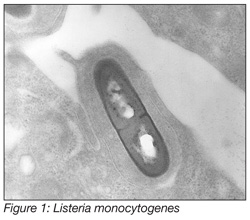 Microbiological contaminants of concern can depend on the type of product and the process through which the product passes. Pathogenic bacteria have been associated with human foodborne illness. They can result in consumer sickness, hospitalization, fatality, recall, liability and loss of business. For this reason, they are of great concern to the consuming public, the food industry and the regulatory agencies. Specific pathogenic organisms that have been most often associated with illness are Listeria monocytogenes (Figure 1), Salmonella and E. coli O157:H7. The primary pathogen of concern for sanitation, particularly in ready-to-eat meat and poultry operations, is L. monocytogenes as it is a ubiquitous organism, meaning it can be found frequently throughout the environment and can grow under a wide range of conditions in food plants. Salmonella and E. coli O157:H7 are not generally considered environmental contaminants; however, they are organisms that need to be removed from the environment.
Microbiological contaminants of concern can depend on the type of product and the process through which the product passes. Pathogenic bacteria have been associated with human foodborne illness. They can result in consumer sickness, hospitalization, fatality, recall, liability and loss of business. For this reason, they are of great concern to the consuming public, the food industry and the regulatory agencies. Specific pathogenic organisms that have been most often associated with illness are Listeria monocytogenes (Figure 1), Salmonella and E. coli O157:H7. The primary pathogen of concern for sanitation, particularly in ready-to-eat meat and poultry operations, is L. monocytogenes as it is a ubiquitous organism, meaning it can be found frequently throughout the environment and can grow under a wide range of conditions in food plants. Salmonella and E. coli O157:H7 are not generally considered environmental contaminants; however, they are organisms that need to be removed from the environment.
Contamination of food products with spoilage microorganisms that do not result in foodborne illness, however, may be the underlying cause for reduction in shelf life of food products. While these organisms is easily eliminated through cooking, they are responsible for spoilage of product in the ambient shelf or refrigerated state. Spoilage organisms include yeast, mold, Lactobacillus, Pseudomonas and rope spores. These are all removed by effective cleaning and sanitation.
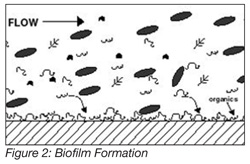 One of the great challenges that face the sanitation team is the formation of biofilms on food equipment surfaces. Food manufacturing plants have recognized that biofilms can have a profound impact on the safety and quality of their products. Their formation has the potential to contaminate product through the introduction of pathogenic microorganisms or spoilage bacteria. They are difficult to remove once they mature as they are resistant to normal sanitation procedures and can result in other detrimental process effects. Even when a food surface appears to be clean, the presence of biofilms is a potential hazard that must be eliminated and prevented from reoccurring. Biofilms begin with a conditioning layer of organic (protein) or inorganic matter forming on an otherwise visually clean food contact surface. The accumulation of organic and inorganic material on processing surfaces creates an environment to which bacteria can adhere. As the layers of bacteria attach to the surface and each other, they trap debris and nutrients and the biofilm begins to take shape. Development and growth, without removal, results in the film becoming irreversibly attached to a substratum or interface or to each other. Biofilms form at a slow but steady rate (Figure 2) and become harder to remove over time. They are most likely to form on rough, penetrable surfaces but can also form on just about any surface. Fortunately, the original biofilm attachment is weak and easy to remove through proper sanitation procedures. Therefore, the film soil must be removed and the most effective method process includes a potable water rinse, soap/cleaner application, mild mechanical action to further loosen soil, final potable water rinse and sanitizing.
One of the great challenges that face the sanitation team is the formation of biofilms on food equipment surfaces. Food manufacturing plants have recognized that biofilms can have a profound impact on the safety and quality of their products. Their formation has the potential to contaminate product through the introduction of pathogenic microorganisms or spoilage bacteria. They are difficult to remove once they mature as they are resistant to normal sanitation procedures and can result in other detrimental process effects. Even when a food surface appears to be clean, the presence of biofilms is a potential hazard that must be eliminated and prevented from reoccurring. Biofilms begin with a conditioning layer of organic (protein) or inorganic matter forming on an otherwise visually clean food contact surface. The accumulation of organic and inorganic material on processing surfaces creates an environment to which bacteria can adhere. As the layers of bacteria attach to the surface and each other, they trap debris and nutrients and the biofilm begins to take shape. Development and growth, without removal, results in the film becoming irreversibly attached to a substratum or interface or to each other. Biofilms form at a slow but steady rate (Figure 2) and become harder to remove over time. They are most likely to form on rough, penetrable surfaces but can also form on just about any surface. Fortunately, the original biofilm attachment is weak and easy to remove through proper sanitation procedures. Therefore, the film soil must be removed and the most effective method process includes a potable water rinse, soap/cleaner application, mild mechanical action to further loosen soil, final potable water rinse and sanitizing.
Chemical contaminants of primary concern are allergen proteins. The "Big 8" allergens that are recognized as significant concern for food manufacturers include eggs, soy, wheat, milk, fish, Crustacea, peanuts and tree nuts. Hu-man allergic reactions to foods are the results of sensitivity to the major protein of the food. For example, the primary protein in egg is albumen. These proteins are often left behind as residue on production surfaces. It is important that the sanitation process be rigorous enough to remove the protein from food contact surfaces.
Other chemicals that can be removed through the sanitation process include hydraulic oil and lubricants. While plants should use lubricants that are H1 rated (food grade) for incidental contact, it is still important to remove surplus grease that may make its way onto contact surfaces from over-lubrication.
Physical contaminants may present a lesser challenge for the sanitation crew but should still be recognized. In grinding, chopping and mixing operations, there is always the possibility that metal shavings or fragments may be left on surfaces due to metal-to-metal contact. The sanitation process may be able to remove these fragments before they enter the product or the product stream. In addition, particles of meat, dough or starch that may form during manufacturing may also be removed during the sanitation process, preventing hardened material that can pose a dental hazard.
The Sanitation Staff
It is the author’s opinion that the sanitation department is one of the most important departments in a food manufacturing facility. It will be difficult to start your plant in the morning, on time, without it being clean. It will be hard to expect to have acceptable product quality and shelf life without a sanitary environment. You may not be able to be certain that your products are safe for consumption without an environment nearly free of pathogens. Finding your sanitation niche often means placing personnel in positions where they fill a specialized niche.
This begins through effective hiring of plant sanitors. What is your process for hiring sanitation personnel? Is your minimum criteria that the sanitors have a pulse and respiration or are you looking for people that have an aptitude for the sanitation process? It’s no secret that they often work in the latest hours of the evening, in wet and humid conditions and around equipment and chemicals. Therefore, the individuals that are hired for the job will have to be motivated to work under these extreme conditions and still be accountable for the conditions of the plant. The sanitation department depends on structure to be effective.
This begins with a strong sanitation supervisor or manager, someone with good leadership attributes, technical skills and problem-solving abilities. It continues with the selection, hiring and training of sanitarians that implement the sanitation process. How do you make sure that we have put sanitation in a position to be the most important department in the plant? Start by hiring a staff that is physically able to do the job, can work the hours required and can handle the conditions. Interview potential sanitation department candidates just as you would candidates for any other position. When interviewing candidates, look for associates who will be conscientious, take pride in their work and be safety conscious. They must also have the acumen to be able to work with chemicals. It may also be necessary to hire sufficient sanitors to account for vacations or illnesses as well as people who decide not to work a particular shift. The sanitation job is challenging enough without being short staffed. As with any other position in the plant, it is also a good idea to cross-train sanitarians to assure that they can function in different roles when the staff is short of people. It is very important to train them to do the job, including safety training regarding personal protective equipment, lock-out tag-out and chemical safety. They will require input as to how they are performing, including recognition when things are done well. It is important to celebrate the successes of the sanitation staff, such as recognition of milestones like consecutive days without an FSIS non-compliance record, consecutive days with an on-time plant start up, increases or improvements in shelf life and reduction in microbial levels as measured by swab tests. It is very important that the sanitation staff understand their contribution to the overall successes and performance of the plant and the company.
Sanitary Design
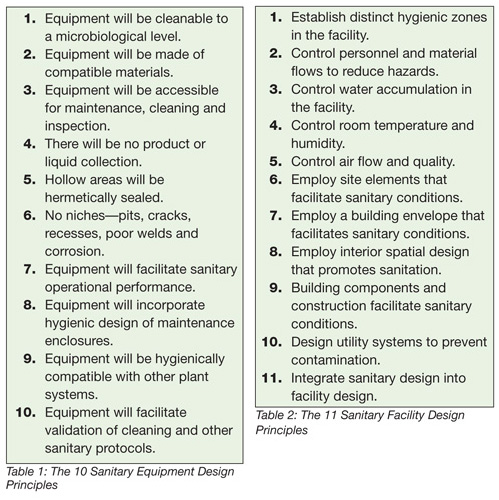 One way of making the sanitation process more effective is through the incorporation of sanitary equipment and sanitary facility design principles. In 2004—2005, an American Meat Institute Facility Design Task Force, a multi-disciplinary team from several food companies as well as design/construction firms, issued 10 sanitary equipment design principles and 11 sanitary facility design principles (Tables 1 and 2). The intent of these principles was to provide food manufacturers with guidelines for design of food equipment and building and construction of food plants for the maximum prevention of microbiological contamination. Although the predomaint members of the task force were from meat and poultry manufacturing companies, there were also participants from food plant engineering groups and construction companies; thus, the principles could be utilized across a wide range of food manufacturing areas. An example of improper tack welds on stairs is shown in Figure 3.
One way of making the sanitation process more effective is through the incorporation of sanitary equipment and sanitary facility design principles. In 2004—2005, an American Meat Institute Facility Design Task Force, a multi-disciplinary team from several food companies as well as design/construction firms, issued 10 sanitary equipment design principles and 11 sanitary facility design principles (Tables 1 and 2). The intent of these principles was to provide food manufacturers with guidelines for design of food equipment and building and construction of food plants for the maximum prevention of microbiological contamination. Although the predomaint members of the task force were from meat and poultry manufacturing companies, there were also participants from food plant engineering groups and construction companies; thus, the principles could be utilized across a wide range of food manufacturing areas. An example of improper tack welds on stairs is shown in Figure 3.
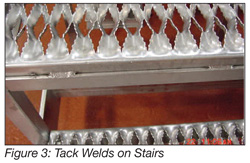
Both sanitary equipment design and sanitary facility design can have an impact on sanitation expense by reducing the amount of chemical needed to clean and sanitize as well as minimizing labor and over time. Sanitary design makes cleaning faster and more efficient. The easier the facility and equipment are to clean, the better the job will be done. However, product protection is the most compelling reason for following basic sanitary design principles. This will be a benefit to the company so make sanitary design part of the overall plant food safety system.
Verification of Sanitation
No sanitation system would be complete without means of verifying effectiveness. Verification may be done by several means from simple and relatively inexpensive to slightly more expensive and complex. The least expensive and easiest to implement is a visual/organo-leptic examination of the post-sanitation and pre-operation environments. Documented organoleptic pre-op inspection is required as part of the plant SSOPs, and there is no regulatory requirement to incorporate other investigative tools. Organoleptic evaluation uses the physical senses of sight, smell and touch. The objective is to verify sanitation by looking and smelling for indication that food residues have not been removed. It is important to have proper tools to assist in the inspection, including a flashlight, ladder for accessing high areas of the equipment or plant and reflective mirror (polished stainless, not glass) to access undersides of equipment. However, added tools and documentation provide extra insight into the thoroughness of the sanitation process. Bioluminescence measurement is an extremely effective, relatively inexpensive tool that many food manufacturers employ for rapid verification feedback about sanitation. Microbiological testing of equipment or environmental surfaces is a tool used by many companies as a means of both verification and validation of sanitation.
Before beginning a microbiological testing program, a company should ask itself four questions:
1. Why do we want to conduct microbiological testing?
2. What tests or test methods will be used?
3. What locations will be sampled and at what frequency?
4. How will the data be collected, analyzed and what actions will be taken based on the data?
It is vitally important to know why you are collecting microbiological testing data and what will be done with the data when it is available. Keep in mind that results of microbiological data are likely accessible to FSIS personnel, especially when the data is used to make decisions for Hazard Analysis Critical Control Point (HACCP) or pre-requisite programs. All findings will require documented follow-up actions to eliminate any positive or high microbiological counts.
GMPs and Pest Control
The sanitation process is also facilitated by the implementation of comprehensive GMPs and an effective pest control program. Once the plant is clean, it is up to plant employees to maintain sanitary conditions. While GMPs may vary, the basic practices may include separation of personnel or equipment between raw and cooked areas, wearing of clean clothes and hair nets, prohibition of eating, drinking, chewing gum or tobacco use in the plant and control of infectious disease. In all cases, these GMPs should be clearly written, reviewed with employees and signed to demonstrate understanding and willingness to comply. It is also vital to have a documented GMP observation program to verify compliance.
The sanitation process will greatly aid in pest control as it will eliminate nutrient sources that pests require for sustenance. Quick clean up of spills, elimination of outside waste storage and cleaning around compactors and dumpsters will prevent the attraction of pests to and inside the plant. Use of screens on doors and windows, air curtains on doors that have to be opened and complete seals around dock load levelers will prevent pests from entering and establishing their own "niche" inside the plant. As with the sanitation program, the pest program must include inspection of conditions inside and outside the plant with documentation of findings and corrective actions.
The sanitation process has many facets that make it vital in a food plant with the primary function to remove contaminating soils and prepare the food surface for sanitizing. The benefits of effective sanitation are production of safe product, improved product shelf life and reduction of off flavors, odors and colors. It will also prevent equipment deterioration and increase production efficiency. Finally, it can be a source of pride and morale to employees who prefer to work in a clean location. By following the steps described, a company can find its sanitation niche.
Michael M. Cramer is Director, Quality Assurance with Windsor Foods. He has more than 30 years’ experience in the food industry and recently authored the book, Food Plant Sanitation: Design, Maintenance and Good Manufacturing Practices. He is a former Director with the National Meat Association, a professional member of the Institute of Food Technologists, a member of the International Association for Food Protection and serves on the Editorial Advisory Board for Food Safety Magazine. He can be reached at michael.cramer@windsorfoods.com.
Food Plant Sanitation: Have You Found Your Niche?


